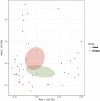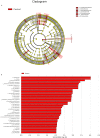Deciphering Gut Microbiota Dysbiosis and Corresponding Genetic and Metabolic Dysregulation in Psoriasis Patients Using Metagenomics Sequencing
- PMID: 33869074
- PMCID: PMC8047475
- DOI: 10.3389/fcimb.2021.605825
Deciphering Gut Microbiota Dysbiosis and Corresponding Genetic and Metabolic Dysregulation in Psoriasis Patients Using Metagenomics Sequencing
Abstract
Background: Increasing evidence has shown that alterations in the intestinal microbiota play an important role in the pathogenesis of psoriasis. The existing relevant studies focus on 16S rRNA gene sequencing, but in-depth research on gene functions and comprehensive identification of microbiota is lacking.
Objectives: To comprehensively identify characteristic gut microbial compositions, genetic functions and relative metabolites of patients with psoriasis and to reveal the potential pathogenesis of psoriasis.
Methods: DNA was extracted from the faecal microbiota of 30 psoriatic patients and 15 healthy subjects, and metagenomics sequencing and bioinformatic analyses were performed. The Kyoto Encyclopedia of Genes and Genomes (KEGG) database, cluster of orthologous groups (COG) annotations, and metabolic analyses were used to indicate relative target genes and pathways to reveal the pathogenesis of psoriasis.
Results: Compared with healthy individuals, the gut microbiota of psoriasis patients displayed an alteration in microbial taxa distribution, but no significant difference in microbial diversity. A distinct gut microbial composition in patients with psoriasis was observed, with an increased abundance of the phyla Firmicutes, Actinobacteria and Verrucomicrobia and genera Faecalibacterium, Bacteroides, Bifidobacterium, Megamonas and Roseburia and a decreased abundance of the phyla Bacteroidetes, Euryarchaeota and Proteobacteria and genera Prevotella, Alistipes, and Eubacterium. A total of 134 COGs were predicted with functional analysis, and 15 KEGG pathways, including lipopolysaccharide (LPS) biosynthesis, WNT signaling, apoptosis, bacterial secretion system, and phosphotransferase system, were significantly enriched in psoriasis patients. Five metabolites, hydrogen sulfide (H2S), isovalerate, isobutyrate, hyaluronan and hemicellulose, were significantly dysregulated in the psoriatic cohort. The dysbiosis of gut microbiota, enriched pathways and dysregulated metabolites are relevant to immune and inflammatory response, apoptosis, the vascular endothelial growth factor (VEGF) signaling pathway, gut-brain axis and brain-skin axis that play important roles in the pathogenesis of psoriasis.
Conclusions: A clear dysbiosis was displayed in the gut microbiota profile, genetic functions and relative metabolites of psoriasis patients. This study is beneficial for further understanding the inflammatory pathogenesis of psoriasis and could be used to develop microbiome-based predictions and therapeutic approaches.
Keywords: genetic functions; gut microbiota; metabolites; metagenomics sequencing; psoriasis.
Copyright © 2021 Xiao, Zhang, Jiang, Liu, Wang, Li, Cheng, Lv, Xian, Guo and Tan.
Conflict of interest statement
MC was employed by the company Beijing QuantiHealth Technology Co., Ltd. The remaining authors declare that the research was conducted in the absence of any commercial or financial relationships that could be construed as a potential conflict of interest.
Figures






Similar articles
-
Gut microbiota dysbiosis in a cohort of patients with psoriasis.Br J Dermatol. 2019 Dec;181(6):1287-1295. doi: 10.1111/bjd.17931. Epub 2019 Jul 18. Br J Dermatol. 2019. PMID: 30920647
-
Dysbiosis of gut microbiota and its correlation with dysregulation of cytokines in psoriasis patients.BMC Microbiol. 2021 Mar 8;21(1):78. doi: 10.1186/s12866-021-02125-1. BMC Microbiol. 2021. PMID: 33685393 Free PMC article.
-
Characteristics of Gut Microbiota in Patients with GH-Secreting Pituitary Adenoma.Microbiol Spectr. 2022 Feb 23;10(1):e0042521. doi: 10.1128/spectrum.00425-21. Epub 2022 Jan 12. Microbiol Spectr. 2022. PMID: 35019688 Free PMC article.
-
Psoriasis and Gut Microbiome-Current State of Art.Int J Mol Sci. 2021 Apr 26;22(9):4529. doi: 10.3390/ijms22094529. Int J Mol Sci. 2021. PMID: 33926088 Free PMC article. Review.
-
Understanding the Role of the Gut Microbiome and Microbial Metabolites in Non-Alcoholic Fatty Liver Disease: Current Evidence and Perspectives.Biomolecules. 2021 Dec 31;12(1):56. doi: 10.3390/biom12010056. Biomolecules. 2021. PMID: 35053205 Free PMC article. Review.
Cited by
-
Fecal microbiota transplantation for the treatment of chronic inflammatory skin diseases.Heliyon. 2024 Sep 7;10(18):e37432. doi: 10.1016/j.heliyon.2024.e37432. eCollection 2024 Sep 30. Heliyon. 2024. PMID: 39309854 Free PMC article. Review.
-
Microbiota and IL-33/31 Axis Linkage: Implications and Therapeutic Perspectives in Atopic Dermatitis and Psoriasis.Biomolecules. 2023 Jul 10;13(7):1100. doi: 10.3390/biom13071100. Biomolecules. 2023. PMID: 37509136 Free PMC article. Review.
-
Investigating the gut microbiota's influence on psoriasis and psoriatic arthritis risk: a Mendelian randomization analysis.Precis Clin Med. 2023 Sep 15;6(3):pbad023. doi: 10.1093/pcmedi/pbad023. eCollection 2023 Sep. Precis Clin Med. 2023. PMID: 38025973 Free PMC article.
-
Cold atmospheric plasma and skin wound healing: influence on microbial diversity and composition.BMC Microbiol. 2025 Apr 30;25(1):260. doi: 10.1186/s12866-025-03965-x. BMC Microbiol. 2025. PMID: 40301741 Free PMC article.
-
Exploring the Therapeutic and Gut Microbiota-Modulating Effects of Qingreliangxuefang on IMQ-Induced Psoriasis.Drug Des Devel Ther. 2025 Apr 28;19:3269-3291. doi: 10.2147/DDDT.S492044. eCollection 2025. Drug Des Devel Ther. 2025. PMID: 40322026 Free PMC article.
References
-
- Bray J. R., Curtis J. T. (1957). An ordination of the upland forest communities of Southern Wisconsin. Eco. Monogr. 27, 325–349. 10.2307/1942268 - DOI
Publication types
MeSH terms
Substances
LinkOut - more resources
Full Text Sources
Other Literature Sources
Medical

